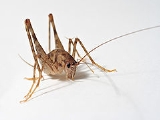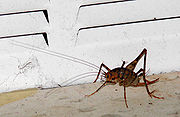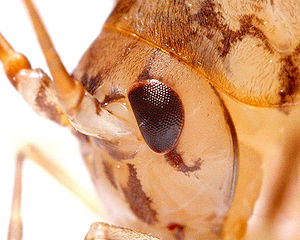
Rhaphidophoridae
Encyclopedia
The orthoptera
n family Rhaphidophoridae includes the cave wetas, cave crickets, camelback crickets, camel crickets, spider crickets (sometimes shortened to "sprickets" or "criders") and sand treaders, of the suborder Ensifera
; in some regions, such as Missouri
and Virginia
, these crickets are referred to as "Cricket Spiders" . Those occurring in New Zealand
, Australia
, and Tasmania
are typically referred to as weta
s. Most are found in association with cave
s, animal burrows, cellars, under stones, in wood or in similar environments. They are characterized in part by their long antenna
e and legs. They may be found on all continents and many continental islands, though Africa has but one species and that is confined to the southern Cape region. The well-known field crickets are from a different superfamily (Grylloidea) and only look vaguely similar, while members of the family Tettigoniidae
may look superficially similar in body form.
 Cave crickets have very large hind legs with "drumstick-shaped" femora, and long, slender antennae. They are brownish in color and rather humpbacked in appearance, always wingless, and up to two inches/5 cm long in body and 10 cm (4 inches) for the legs. The bodies of baby crickets may appear translucent. As the name implies, cave crickets are commonly found in caves. However, most species live in other cool, damp situations such as in wells, rotten logs, stumps and hollow trees, and under damp leaves, stones, boards, and logs. Occasionally, they prove to be a nuisance in the basements of homes in suburban areas. Some reach into alpine areas and live close to permanent ice — the Mount Cook "flea" and its relatives in New Zealand.
Cave crickets have very large hind legs with "drumstick-shaped" femora, and long, slender antennae. They are brownish in color and rather humpbacked in appearance, always wingless, and up to two inches/5 cm long in body and 10 cm (4 inches) for the legs. The bodies of baby crickets may appear translucent. As the name implies, cave crickets are commonly found in caves. However, most species live in other cool, damp situations such as in wells, rotten logs, stumps and hollow trees, and under damp leaves, stones, boards, and logs. Occasionally, they prove to be a nuisance in the basements of homes in suburban areas. Some reach into alpine areas and live close to permanent ice — the Mount Cook "flea" and its relatives in New Zealand.
Their distinctive limbs and antennae serve a double purpose. Typically living in a lightless environment, or active at night, they rely heavily on their sense of touch, which is limited by reach. While they have been known to take up residence in the basements of buildings, many cave crickets live out their entire lives deep inside actual caves. In those habitats they sometimes face long spans of time with insufficient access to nutrients. To avoid starvation, they have been known to devour their own extremities, even though they cannot regenerate limbs. Given their limited vision, cave crickets will often jump towards any perceived threat in an attempt to frighten it away. Although they look intimidating, they are completely harmless.http://www.asktheexterminator.com/Crickets/Camelback_Crickets.shtml
Cave and camel crickets are of little economic importance except as a nuisance in buildings and homes, especially basements. They are usually "accidental invaders" that wander in by mistake from adjacent areas. They generally reproduce indoors, especially in situations that provide continuous dark, moist conditions, such as a basement shower or laundry area, as well as organic debris to serve as food.
The group known as "sand treaders" are restricted to sand dunes, however, and are adapted to live in this environment. They are active only at night, and spend the day burrowed into the sand, to minimize water loss. In the large sand-dunes of California and Utah they serve as food for scorpions.


An as-yet-unnamed genus was discovered within a cave in Grand Canyon Parashant National Monument, on the Utah/Arizona border, in 2005. Its most distinctive characteristic is that it has functional grasping cerci
on its posterior.http://dsc.discovery.com/news/2006/07/26/cricket_ani.html?category=animals&guid=20060726103000
Orthoptera
Orthoptera is an order of insects with paurometabolous or incomplete metamorphosis, including the grasshoppers, crickets and locusts.Many insects in this order produce sound by rubbing their wings against each other or their legs, the wings or legs containing rows of corrugated bumps...
n family Rhaphidophoridae includes the cave wetas, cave crickets, camelback crickets, camel crickets, spider crickets (sometimes shortened to "sprickets" or "criders") and sand treaders, of the suborder Ensifera
Ensifera
Ensifera is a suborder of the order Orthoptera, comprising insects commonly known as crickets, katydids and bush crickets. "Ensifer" means "sword bearer" in Latin, and refers to the typically elongated and blade-like ovipositor of the females...
; in some regions, such as Missouri
Missouri
Missouri is a US state located in the Midwestern United States, bordered by Iowa, Illinois, Kentucky, Tennessee, Arkansas, Oklahoma, Kansas and Nebraska. With a 2010 population of 5,988,927, Missouri is the 18th most populous state in the nation and the fifth most populous in the Midwest. It...
and Virginia
Virginia
The Commonwealth of Virginia , is a U.S. state on the Atlantic Coast of the Southern United States. Virginia is nicknamed the "Old Dominion" and sometimes the "Mother of Presidents" after the eight U.S. presidents born there...
, these crickets are referred to as "Cricket Spiders" . Those occurring in New Zealand
New Zealand
New Zealand is an island country in the south-western Pacific Ocean comprising two main landmasses and numerous smaller islands. The country is situated some east of Australia across the Tasman Sea, and roughly south of the Pacific island nations of New Caledonia, Fiji, and Tonga...
, Australia
Australia
Australia , officially the Commonwealth of Australia, is a country in the Southern Hemisphere comprising the mainland of the Australian continent, the island of Tasmania, and numerous smaller islands in the Indian and Pacific Oceans. It is the world's sixth-largest country by total area...
, and Tasmania
Tasmania
Tasmania is an Australian island and state. It is south of the continent, separated by Bass Strait. The state includes the island of Tasmania—the 26th largest island in the world—and the surrounding islands. The state has a population of 507,626 , of whom almost half reside in the greater Hobart...
are typically referred to as weta
Weta
Weta is the name given to about 70 insect species endemic to New Zealand. There are many similar species around the world, though most are in the southern hemisphere. The name comes from the Māori word 'wētā' and is the same in the plural...
s. Most are found in association with cave
Cave
A cave or cavern is a natural underground space large enough for a human to enter. The term applies to natural cavities some part of which is in total darkness. The word cave also includes smaller spaces like rock shelters, sea caves, and grottos.Speleology is the science of exploration and study...
s, animal burrows, cellars, under stones, in wood or in similar environments. They are characterized in part by their long antenna
Antenna (biology)
Antennae in biology have historically been paired appendages used for sensing in arthropods. More recently, the term has also been applied to cilium structures present in most cell types of eukaryotes....
e and legs. They may be found on all continents and many continental islands, though Africa has but one species and that is confined to the southern Cape region. The well-known field crickets are from a different superfamily (Grylloidea) and only look vaguely similar, while members of the family Tettigoniidae
Tettigoniidae
The family Tettigoniidae, known in American English as katydids and in British English as bush-crickets, contains more than 6,400 species. It is part of the suborder Ensifera and the only family in the superfamily Tettigonioidea. They are also known as long-horned grasshoppers, although they are...
may look superficially similar in body form.
Description

Their distinctive limbs and antennae serve a double purpose. Typically living in a lightless environment, or active at night, they rely heavily on their sense of touch, which is limited by reach. While they have been known to take up residence in the basements of buildings, many cave crickets live out their entire lives deep inside actual caves. In those habitats they sometimes face long spans of time with insufficient access to nutrients. To avoid starvation, they have been known to devour their own extremities, even though they cannot regenerate limbs. Given their limited vision, cave crickets will often jump towards any perceived threat in an attempt to frighten it away. Although they look intimidating, they are completely harmless.http://www.asktheexterminator.com/Crickets/Camelback_Crickets.shtml
Cave and camel crickets are of little economic importance except as a nuisance in buildings and homes, especially basements. They are usually "accidental invaders" that wander in by mistake from adjacent areas. They generally reproduce indoors, especially in situations that provide continuous dark, moist conditions, such as a basement shower or laundry area, as well as organic debris to serve as food.
The group known as "sand treaders" are restricted to sand dunes, however, and are adapted to live in this environment. They are active only at night, and spend the day burrowed into the sand, to minimize water loss. In the large sand-dunes of California and Utah they serve as food for scorpions.
Subfamilies and genera

- Subfamily Aemodogryllinae — cave crickets: Asia (Korea, Indochina, Russia, China)
- Diestrammena
- Eutachycines
- Microtachycines
- Paradiestrammena
- Paratachycines
- Adiestramima Gorochov, 1998
- Diestramima Storozhenko, 1990
- Gigantettix Gorochov, 1998
- Megadiestramima Storozhenko & Gorochov, 1992
- Tamdaotettix Gorochov, 1998
- Atachycines Furukawa, 1933
- Neotachycines Sugimoto & Ichikawa, 2003
- Subfamily Ceuthophilinae — cave crickets, camel crickets & sand treaders: United States
- Ammobaenetes Hubbell, 1936
- Ceuthophilus Scudder, 1863
- Daihinia Haldeman, 1850
- DaihinibaenetesDaihinibaenetesDaihinibaenetes is a genus of cricket in family Rhaphidophoridae. It contains the species Daihinibaenetes arizonensis....
Tinkham, 1962 - Daihiniella Hubbell, 1936
- Daihiniodes Hebard, 1929
- Farallonophilus Rentz, 1972
- MacrobaenetesMacrobaenetesMacrobaenetes is a genus of insect in family Rhaphidophoridae. It contains the species Macrobaenetes kelsoensis and M. valgum....
Tinkham, 1962 - Phrixocnemis Scudder, 1894
- PristoceuthophilusPristoceuthophilusPristoceuthophilus is a genus of insect in family Rhaphidophoridae named by James A. G. Rehn in 1903.It contains the following species:*Pristoceuthophilus arizonae Hebard, 1935*Pristoceuthophilus celatus...
Rehn, 1903 - Rhachocnemis Caudell, 1916
- Salishella Hebard, 1939
- Styracosceles Hubbell, 1936
- Typhloceuthophilus Hubbell, 1940
- Udeopsylla Scudder, 1863
- UtabaenetesUtabaenetesUtabaenetes is a genus of insect in family Rhaphidophoridae containing the species Utabaenetes tanneri....
Tinkham, 1970

- Subfamily Dolichopodainae — cave crickets: Mediterranean
- Dolichopoda
- Subfamily Hadenoecinae — cave crickets: United States
- Euhadenoecushttp://luirig.altervista.org/biology/main.php?taxon=Euhadenoecus Hubbell, 1978
- HadenoecusHadenoecusHadenoecus is a genus of common cave cricket of the southeastern United States. The Mammoth Cave system in central Kentucky is populated by the species Hadenoecus subterraneous....
Scudder, 1863
- Subfamily Macropathinae — cave wetas: Australia, Chile, New Zealand
- Dendroplectron
- GymnoplectronGymnoplectronGymnoplectron is a genus of cave weta in the family Rhaphidophoridae, endemic to New Zealand.-Species:* Gymnoplectron acanthocerum * Gymnoplectron delli * Gymnoplectron edwardsii...
- Insulanoplectron
- Ischyroplectron
- IsoplectronIsoplectronIsoplectron is a genus of cave weta in the family Rhaphidophoridae, endemic to New Zealand.-Species:* Isoplectron aciculatum Karny, 1937* Isoplectron armatum Hutton, 1897* Isoplectron calcaratum Hutton, 1897...
- MacropathusMacropathusMacropathus is a genus of cave weta in the family Rhaphidophoridae, endemic to New Zealand.-Species:* Macropathus filifer Walker, 1869* Macropathus huttoni Kirby, 1906...
- NeonetusNeonetusNeonetus is a genus of cave weta in the family Rhaphidophoridae, endemic to New Zealand.-Species:* Neonetus huttoni Chopard, 1923* Neonetus pilosus * Neonetus poduroides...
- NovoplectronNovoplectronNovoplectron is a genus of cave weta in the family Rhaphidophoridae, endemic to offshore islands of New Zealand.-Species:* Novoplectron serratum Hutton, 1897* Notoplectron campbellense Richards, 1964...
- PachyrhammaPachyrhammaPachyrhamma is a genus of cave weta in the family Rhaphidophoridae, endemic to New Zealand.-Species:* Pachyrhamma acanthocera * Pachyrhamma chopardi Karny, 1935* Pachyrhamma edwardsi...
Brunner von Wattenwyl, 1888 - PallidoplectronPallidoplectronPallidoplectron is a genus of cave weta in the family Rhaphidophoridae, endemic to New Zealand.-Species:* Pallidoplectron peniculosum Richards, 1960* Pallidoplectron subterraneum Richards, 1965...
- Paraneonetus
- PetrotettixPetrotettixPetrotettix is a genus of cave weta in the family Rhaphidophoridae, endemic to New Zealand.-Species:* Petrotettix cupolensis Richards, 1972* Petrotettix nigripes Richards, 1972* Petrotettix serratus Richards, 1972...
- PharmacusPharmacusPharmacus is a genus of cave weta in the family Rhaphidophoridae, endemic to New Zealand.-Species:* Pharmacus brewsterensis Richards, 1972* Pharmacus chapmanae Richards, 1972* Pharmacus dumbletoni Richards, 1972...
- PleioplectronPleioplectronPleioplectron is a genus of cave weta in the family Rhaphidophoridae, endemic to New Zealand.-Species:* Pleioplectron diversum Hutton, 1897* Pleioplectron hudsoni Hutton, 1897* Pleioplectron simplex Hutton, 1897...
- SetascutumSetascutumSetascutum is a genus of cave weta in the family Rhaphidophoridae, endemic to New Zealand.-Species:* Setascutum ohauense Richards, 1972* Setascutum pallidum Richards, 1972...
- TalitropsisTalitropsisTalitropsis is a genus of cave weta in the family Rhaphidophoridae, endemic to New Zealand.-Species:* Talitropsis crassicruris Hutton, 1897* Talitropsis irregularis Hutton, 1897* Talitropsis sedilloti Bolivar, 1883...
- TurbottoplectronTurbottoplectronTurbottoplectron is a genus of cave weta in the family Rhaphidophoridae, endemic to New Zealand.-Species:* Turbottoplectron cavernae * Turbottoplectron unicolor Salmon, 1948...
- WetaWeta (genus)Weta is a genus of cave weta in the family Rhaphidophoridae, endemic to New Zealand.-Species:* Weta thomsoni Chopard, 1923* Weta chopardi Karny, 1937-References:*...
- Subfamily †ExtinctionIn biology and ecology, extinction is the end of an organism or of a group of organisms , normally a species. The moment of extinction is generally considered to be the death of the last individual of the species, although the capacity to breed and recover may have been lost before this point...
Protroglophilinae- † Protroglophilus
- Subfamily Rhaphidophorinae — camel crickets: United States
- Gammarotettix Brunner, 1888
- Subfamily Troglophilinae — cave crickets: Mediterranean
- Troglophilus
- Subfamily Tropidischiinae — camel crickets: Canada
- Tropidischia Scudder, 1869
An as-yet-unnamed genus was discovered within a cave in Grand Canyon Parashant National Monument, on the Utah/Arizona border, in 2005. Its most distinctive characteristic is that it has functional grasping cerci
Cercus
Cerci are paired appendages on the rear-most segments of many arthropods, including insects and arachnids but not crustaceans. Cerci often serve as sensory organs, but they may also be used as weapons or copulation aids, or they may simply be vestigial structures.Typical cerci may appear to be...
on its posterior.http://dsc.discovery.com/news/2006/07/26/cricket_ani.html?category=animals&guid=20060726103000

